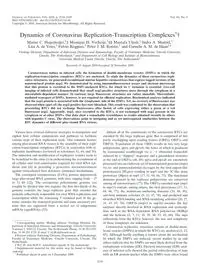Table Of ContentJOURNAL OF VIROLOGY, Feb. 2010, p. 2134–2149
Vol. 84, No. 4
0022-538X/10/$12.00
doi:10.1128/JVI.01716-09
Copyright © 2010, American Society for Microbiology. All Rights Reserved.
Dynamics of Coronavirus Replication-Transcription Complexes�†
Marne C. Hagemeijer,1‡ Monique H. Verheije,1‡§ Mustafa Ulasli,2 Indra A. Shaltie¨l,1
Lisa A. de Vries,1 Fulvio Reggiori,2 Peter J. M. Rottier,1 and Cornelis A. M. de Haan1*
Virology Division, Department of Infectious Diseases and Immunology, Faculty of Veterinary Medicine, Utrecht University,
Utrecht, The Netherlands,1 and Department of Cell Biology and Institute of Biomembranes,
University Medical Centre Utrecht, Utrecht, The Netherlands2
Received 15 August 2009/Accepted 24 November 2009
Coronaviruses induce in infected cells the formation of double-membrane vesicles (DMVs) in which the
replication-transcription complexes (RTCs) are anchored. To study the dynamics of these coronavirus repli-
cative structures, we generated recombinant murine hepatitis coronaviruses that express tagged versions of the
nonstructural protein nsp2. We demonstrated by using immunofluorescence assays and electron microscopy
that this protein is recruited to the DMV-anchored RTCs, for which its C terminus is essential. Live-cell
imaging of infected cells demonstrated that small nsp2-positive structures move through the cytoplasm in a
microtubule-dependent manner. In contrast, large fluorescent structures are rather immobile. Microtubule-
mediated transport of DMVs, however, is not required for efficient replication. Biochemical analyses indicated
that the nsp2 protein is associated with the cytoplasmic side of the DMVs. Yet, no recovery of fluorescence was
observed when (part of) the nsp2-positive foci were bleached. This result was confirmed by the observation that
preexisting RTCs did not exchange fluorescence after fusion of cells expressing either a green or a red
fluorescent nsp2. Apparently, nsp2, once recruited to the RTCs, is not exchanged with nsp2 present in the
cytoplasm or at other DMVs. Our data show a remarkable resemblance to results obtained recently by others
with hepatitis C virus. The observations point to intriguing and as yet unrecognized similarities between the
RTC dynamics of different plus-strand RNA viruses.
Viruses have evolved elaborate strategies to manipulate and
exploit host cellular components and pathways to facilitate
various steps of their replication cycle. One common feature
among plus-strand RNA viruses is the assembly of their repli-
cation-transcription complexes (RTCs) in association with cy-
toplasmic membranes (reviewed in references 41, 44, and 54).
The induction and modification of replicative vesicles seem to
be beneficial to the virus (i) in orchestrating the recruitment of
all cellular and viral constituents required for viral RNA syn-
thesis and (ii) in providing a protective microenvironment
against virus-elicited host defensive (immune) mechanisms.
The enveloped coronaviruses (CoVs) possess impressively
large plus-strand RNA genomes, with sizes ranging from �27
to 32 kb (22). The coronavirus polycistronic genome can
roughly be divided into two regions: the first two-thirds of the
genome contains the large replicase gene that encodes the
proteins collectively responsible for viral RNA replication and
transcription while the remaining 3�-terminal part of the ge-
nome encodes the structural proteins and some accessory pro-
teins that are expressed from a nested set of subgenomic
mRNAs (sgmRNAs) (55).
Almost all of the constituents of the coronavirus RTCs are
encoded by the large replicase gene that is comprised of two
partly overlapping open reading frames (ORFs), ORF1a and
ORF1b. Translation of these ORFs results in two very large
polyproteins, pp1a and pp1ab, the latter of which is produced
by translational readthrough via a �1 ribosomal frameshift
induced by a “slippery” sequence and a pseudoknot structure
at the end of ORF1a (46, 69). pp1a and pp1ab are extensively
processed into an elaborate set of nonstructural proteins (nsps)
via co- and posttranslational cleavages by the viral papain-like
proteinase(s) (PLpro) residing in nsp3 and the 3C-like main
proteinase (Mpro) in nsp5 (17, 51, 64, 66, 77). The functional
domains present in the replicase polyproteins are conserved
among all coronaviruses (77). The ORF1a-encoded nsps (nsp1
to nsp11) contain, among others, the viral proteinases (17, 51,
64, 66, 77), the membrane-anchoring domains (34, 48, 49),
anti-host immune activities (8, 32, 47, 78), and predicted and
identified RNA-binding and RNA-modifying activities (20, 27,
31, 43, 67, 76). ORF1b (nsp12 to nsp16) encodes the key
enzymes directly involved in RNA replication and transcrip-
tion, such as the RNA-dependent RNA polymerase (RdRp)
and the helicase (2, 7, 11, 18, 29, 30, 33, 45, 60). The nsps
collectively form the RTCs; however, the size and complexity
of these complexes are unknown.
Coronavirus replicative structures consist of double-mem-
brane vesicles (DMVs) in which the RTCs are anchored (3, 23,
65). Although hardly anything is known about the mechanism
by which the DMVs are induced, recent studies by us and
others indicate that the DMVs are most likely derived from the
endoplasmic reticulum (ER). Electron microscopy (EM) anal-
yses of infected cells showed the partial colocalization of nsps
with an ER protein marker while the DMVs were often found
* Corresponding author. Mailing address: Virology Division, De-
partment of Infectious Diseases and Immunology, Utrecht University,
Yalelaan 1, 3584 CL Utrecht, The Netherlands. Phone: 31 30 253 4195.
Fax: 31 30 253 6723. E-mail:

